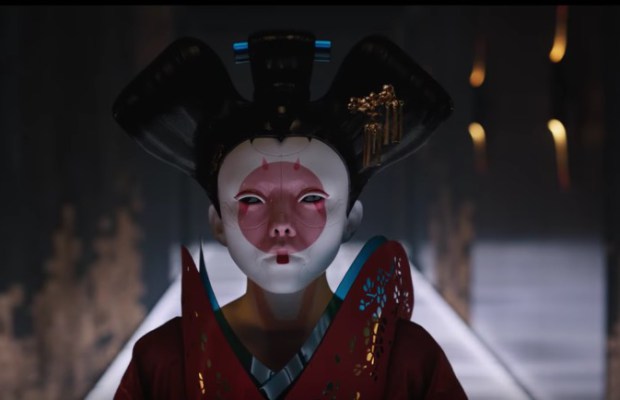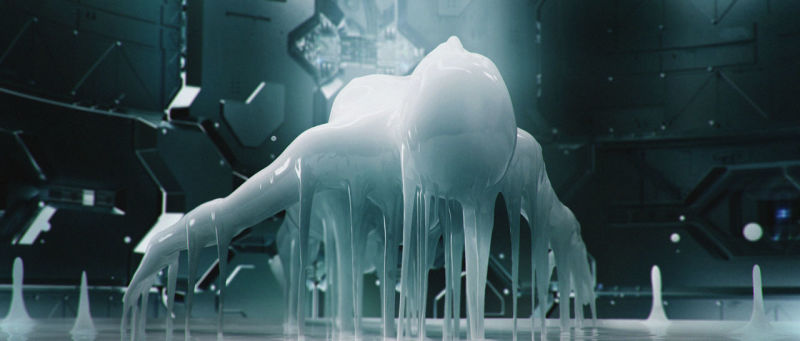Ghost in the Shell (2017)
March 29, 2017 · 0 comments
by Jeremy Clarke.  Major (Scarlett Johansson) is the first of her kind – rescued from a refugee boat many years ago and cyber-enhanced to be the perfect soldier. Only her mind remains; the rest of her is artificial, putting her in a unique position as society faces a new threat. Cyber warfare has evolved to a point where cybernetic implants can be hacked – innocent people can be weaponised as terrorists. Their memories can be removed and replaced with new ones. Major, in the front line of fighting such terrorists, begins to wonder if her own memories have been implanted when she was rebuilt. Is she really the person whose past she remembers…? Or is she someone else altogether…?
Major (Scarlett Johansson) is the first of her kind – rescued from a refugee boat many years ago and cyber-enhanced to be the perfect soldier. Only her mind remains; the rest of her is artificial, putting her in a unique position as society faces a new threat. Cyber warfare has evolved to a point where cybernetic implants can be hacked – innocent people can be weaponised as terrorists. Their memories can be removed and replaced with new ones. Major, in the front line of fighting such terrorists, begins to wonder if her own memories have been implanted when she was rebuilt. Is she really the person whose past she remembers…? Or is she someone else altogether…?
The first thing to say about DreamWorks’ live-action Ghost in the Shell is that it’s really rather good, despite the long-running media controversy over its “whitewashing” – recasting Asians with Caucasian actors. And ever since the trailer first appeared, admirers of Mamoru Oshii’s seminal 1995 anime version have been wondering what other compromises have been made.
Masamune Shirow’s original 1989 manga was set forty years into the future, in Newport City, a floating metropolis in “a strange, corporate conglomerate-state called Japan”. Fast-forward to the Oshii animated version and while Major Motoko Kusanagi and her colleagues are still Japanese-speaking, the location was a little hazier. You could believe you were still in Japan, and it’s briefly referred to as Newport City, but the designers modelled much of its backgrounds, architecture and kipple on Hong Kong.
In the 2017 film, Newport City has been actually shot on location in Hong Kong. Some variation of the Tardis translation circuit now means that everybody understands each other, regardless of what language they are speaking. Being a US movie, it also has an international cast, with big-name stars sufficient to open a studio blockbuster in the English-speaking world. So America’s Scarlett Johansson plays the leading lady referred to mostly as Major. Denmark’s Pilou Asbæk is sidekick Batou; Japan’s Takeshi Kitano is boss Aramaki; France’s Juliette Binoche is boffin Dr. Ouelet; Romanian Anamaria Marinca is lesser boffin Dr. Dahlin; Australia’s Lasarus Ratuere is Ishikawa; Singapore’s Chin Han is Togusa. America’s Michael Pitt plays the villain Kuze, a character lifted not from the manga or the anime feature, but from the later Stand Alone Complex 2nd Gig “Individual Eleven” story arc. By the time Japan’s Kaori Momoi turns up, the script has suggested that Major was once called Motoko, the name of her character’s lost daughter..
 Chin Han is given little to do, and it’s fair to say Asians are under-represented. Kitano speaks subtitled Japanese throughout, and this is touted as his Hollywood film acting debut, so clearly appearances in Johnny Mnemonic (1995) and Brother (2000) didn’t count. Kitano’s as good here as in the best of his self-directed films. Kaori Momoi only has a couple of scenes, but is magnificent in them. While director Rupert Sanders coaxes strong performances from all members of the main cast, from Johansson on down, you wish the production had tried a bit harder to find a few more Asian faces.
Chin Han is given little to do, and it’s fair to say Asians are under-represented. Kitano speaks subtitled Japanese throughout, and this is touted as his Hollywood film acting debut, so clearly appearances in Johnny Mnemonic (1995) and Brother (2000) didn’t count. Kitano’s as good here as in the best of his self-directed films. Kaori Momoi only has a couple of scenes, but is magnificent in them. While director Rupert Sanders coaxes strong performances from all members of the main cast, from Johansson on down, you wish the production had tried a bit harder to find a few more Asian faces.
One of the anime’s defining images is right at the start, when Kusanagi undoes her coat, high up on a skyscraper, to reveal nothing except a pair of above-the-knee boots and a garter-like gun holster. She then drops many floors below to create gun-toting mayhem, using thermoptic camouflage to appear invisible. The scene features in Shirow’s manga but without the removal of the coat. Later, after the anime’s water fight scene, Kusanagi switches off her camouflage headgear and stands “nude” save for what appear to be white stockings. In the new film, Johansson also plays the character “nude”, but not the familiar nudity of human flesh. It’s the nudity of flesh that is industrially reconstructed rather than organically human. Strangely, Major’s breasts are exposed but she now has no nipples. Yet as the film continues, the bodysuit device seems to work rather better than those out-of-context trailer clips suggested it would.
But the Major was never quite “nude” in the anime, either. Look closely in the anime and you’ll see a line around Kusanagi’s neck – a prosthetic, constructional join. If you photograph drawn animation using areas of flat flesh colour, those are likely to read as flesh, not prosthetics or industrial construct. Arguably, this allowed the anime to have its cake and eat it, much as the infamous Dirty Pair were never “really” wearing bikinis – they were wearing transparent full-body spacesuits that merely had bikini-like modesty paint. Try and imagine a live-action character nude like that in a US studio blockbuster movie. It’s never going to happen.
 More questionable, however, is why the nudity in the first place? Would thermoptics work without it, as Shirow’s manga suggests? Was it just an excuse for Oshii to show some female flesh and pander to the male gaze? In the new film, is it a cop-out having Johansson unclothed and reconstructed even if the actress is not technically nude? Or are Oshii’s striking images so integral and seminal that they can’t ever be excised from the franchise?
More questionable, however, is why the nudity in the first place? Would thermoptics work without it, as Shirow’s manga suggests? Was it just an excuse for Oshii to show some female flesh and pander to the male gaze? In the new film, is it a cop-out having Johansson unclothed and reconstructed even if the actress is not technically nude? Or are Oshii’s striking images so integral and seminal that they can’t ever be excised from the franchise?
Both the jumping and the water fight scenes are repeated in the new film, both are highly effective. When I say repeated, I don’t mean in the sense that the new Beauty and the Beast is more or less a live-action remake of the animated original. They are different media, after all. In the anime, you marvel at the skill of the animators in bringing such a thing to life; in the live-action version, there is a different skillset involved – you marvel at the physicality of the performer and the creation of the special effects. Buildings or entire skylines are covered with holographic neon displays to make the cityscapes here as memorable as those in Metropolis, Blade Runner or The Fifth Element. As if that wasn’t enough, the new film also realises the anime’s spider tank in a highly convincing manner.
The 1995 Ghost in the Shell had weaknesses as well as strengths. Scenes of great resonance and ethereal beauty jostled with minimally animated dialogue scenes. The dialogue and the ideas behind it were fascinating in these latter scenes, although the animation at those points was pedestrian. In the new film, the large backdrops and action set pieces work well, but under Sanders’ guidance the quieter moments of dialogue and inner character turmoil prove far more affecting.
Whitewash aside, Johansson seems an almost perfect fit for Major. But she’s hardly “the first of her kind” for anyone with a passing acquaintance with science fiction. Drawing once more on the Stand Alone Complex storyline, but recalling flashback glitches in Robocop and doubtful recollections in Blade Runner, her character arc asks whether our memories define us, even if they prove to be false. How do you build a character as an actor when there’s… no background? Johansson achieves a deeply affecting inner vulnerability, taking us on a journey to find out exactly who she is.
Another pleasant surprise for admirers of the anime is the music. As the credits roll and you’re already feeling good that film isn’t just good, it’s great, Kenji Kawai’s memorable score kicks in at just the right moment. Now, that was something that was infamously missing from the anime’s closing credits, at least in its English-language release!
Ghost in the Shell is released in the UK and Ireland on 30th March 2017.
anime, cinema, ghost in the shell, Hong Kong, Japan, Jeremy Clarke, Mamoru Oshii, Masamune Shirow
Leave a Reply